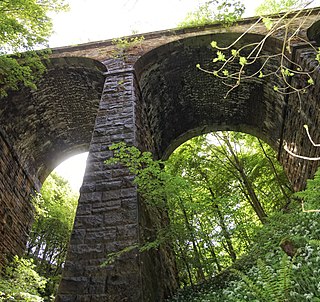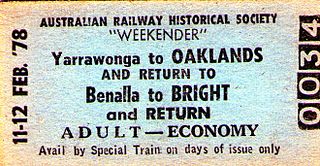
The Beeching cuts, also colloquially referred to as the Beeching Axe, were a major series of route closures and service changes made as part of the restructuring of the nationalised railway system in Great Britain in the 1960s. They are named for Dr. Richard Beeching, then-chair of the British Railways Board and the author of two reports – The Reshaping of British Railways (1963) and The Development of the Major Railway Trunk Routes (1965) – that outlined the necessity of improving the efficiency of the railways and the plan for achieving this through restructuring.

Kensington (Olympia) is an interchange station located in Kensington, in West London for London Overground and National Rail services. Limited London Underground services also run here.

Camberwell railway station is a commuter railway station and the junction point for the Alamein, Belgrave and Lilydale lines, which are all part of the Melbourne railway network. It serves the eastern suburb of Camberwell, in Melbourne, Victoria, Australia. Camberwell station is a ground level premium station, featuring three platforms, an island platform with two faces and one side platform connected by a ramp and accessible overground concourse. It opens on 3 April 1882, with the current station provided in 1919.

The Penistone Line is operated by Northern Trains in the West Yorkshire Metro and Travel South Yorkshire areas of northern England. It connects Huddersfield and Sheffield via Penistone and Barnsley, serving many rural communities. Metrocards can be used for travel between Huddersfield and Denby Dale and intermediate stations.

The St Ives Bay Line is a 4.25 miles (6.84 km) railway line from St Erth to St Ives in Cornwall, England, United Kingdom. It was opened in 1877, the last new 7 ft broad gauge passenger railway to be constructed in the country. Converted to standard gauge in 1892, it continues to operate as a community railway, carrying tourists as well as local passengers. It has five stations including the junction with the Cornish Main Line at St Erth.

Bright is a town in northeastern Victoria, Australia, 319 metres above sea level at the southeastern end of the Ovens Valley. At the 2021 census, Bright had a population of 2,620. It is located in the Alpine Shire local government area.

The Ovens River, a perennial river of the north-east Murray catchment, part of the Murray-Darling basin, is located in the Alpine and Hume regions of the Australian state of Victoria.

Stanmore Village railway station was a station in Stanmore, Middlesex in the south of England. Originally called simply Stanmore, it was opened on 18 December 1890 by the Harrow and Stanmore Railway, a company owned by the hotel millionaire Frederick Gordon, as the terminus of the Stanmore branch line, a short branch line running north from Harrow & Wealdstone. Trains were operated by the London & North Western Railway (LNWR).

Batley railway station serves the market town of Batley in West Yorkshire, England. Situated 8 miles (13 km) south-west of Leeds on the main line to Huddersfield and Manchester, the station was opened by the London and North Western Railway in 1848.

Bow was a railway station in Bow, east London, that was opened in 1850 by the East & West India Docks and Birmingham Junction Railway, which was later renamed the North London Railway (NLR). The station was situated between Old Ford and South Bromley, and was located on the north side of Bow Road, close to the second Bow Road station which was open from 1892 to 1949. A covered footway connected the two stations between 1892 and 1917.
The North East railway line is a railway line in Victoria, Australia. The line runs from Southern Cross railway station on the western edge of the Melbourne central business district to Albury railway station in the border settlement of Albury-Wodonga, serving the cities of Wangaratta and Seymour, and smaller towns in northeastern Victoria.

The Myrtleford Alpine Saints Football Netball Club, is an Australian rules football and netball club based in the town of Myrtleford, in north east Victoria on the Ovens River. The football and netball squads play in the Ovens & Murray Football League (OMFL).

Porepunkah is a town in northeast Victoria, Australia on the Great Alpine Road, at the foot of Mount Buffalo 320 kilometres (199 mi) northeast of the state capital, Melbourne and 5 kilometres (3 mi) northwest of Bright. It is part of Alpine Shire local government area and on the banks of the Ovens River, near the Buckland River junction. At the 2016 census, Porepunkah had a population of 941.
The Murray to Mountains Rail Trail is a cycling and walking rail trail in northern Victoria, Australia. It extends from Wangaratta to Bright, with a side branch to Beechworth, following the route of the former Bright railway line. This side branch trail is planned to be extended from Beechworth to Yackandandah. AU$12m was budgeted by the Victoria State Government for this extension in May 2017. Unusually for a rail trail, it is sealed for virtually the entire distance of approximately 95 kilometres.

The Ovens & King Football Netball League is a minor country Australian rules football and netball league based in North-Eastern Victoria in the vicinity of Wangaratta and more recently Benalla.
Myrtleford railway station was located on the Bright line serving the town of Myrtleford in Victoria. It opened on 17 December 1883 as the terminus of the line. On 17 October 1890, the line was extended to Bright. On 30 November 1983 it again became the terminus when the line to Bright closed. It along with the rest of the line closed on 13 April 1987.

The Bright railway line was a railway line in Victoria, Australia constructed by the Victorian Railways as a branch from the previously constructed Yackandandah line to Beechworth, with the Bright line branching at Everton. The line followed the Ovens Valley opening as far as Myrtleford on 17 December 1883 being extended to Bright on 17 October 1890.

St Clement's Church is a historic former Church of England building located at 5958 Great Alpine Road, Eurobin, Alpine Shire, Victoria, Australia. It is listed as a heritage site by the Alpine Shire Council, and is the only remaining community building in Eurobin.

Eurobin is a rural locality in the Ovens Valley, northeastern Victoria, Australia, situated approximately midway between the towns of Myrtleford and Bright. Formerly known as Black Springs until 1870, the name Eurobin is believed to be derived from an Aboriginal word describing a lake at the base of a mountain.

The Eurobin Presbyterian Church was a wooden church located in Eurobin, Victoria, Australia. It was established as part of the Bright (Myrtleford) charge under the Presbytery of Beechworth and later the Presbytery of North East. Though no longer standing, the church holds historical significance as one of two churches in the small township of Eurobin, alongside St. Clement's Church of England.



















